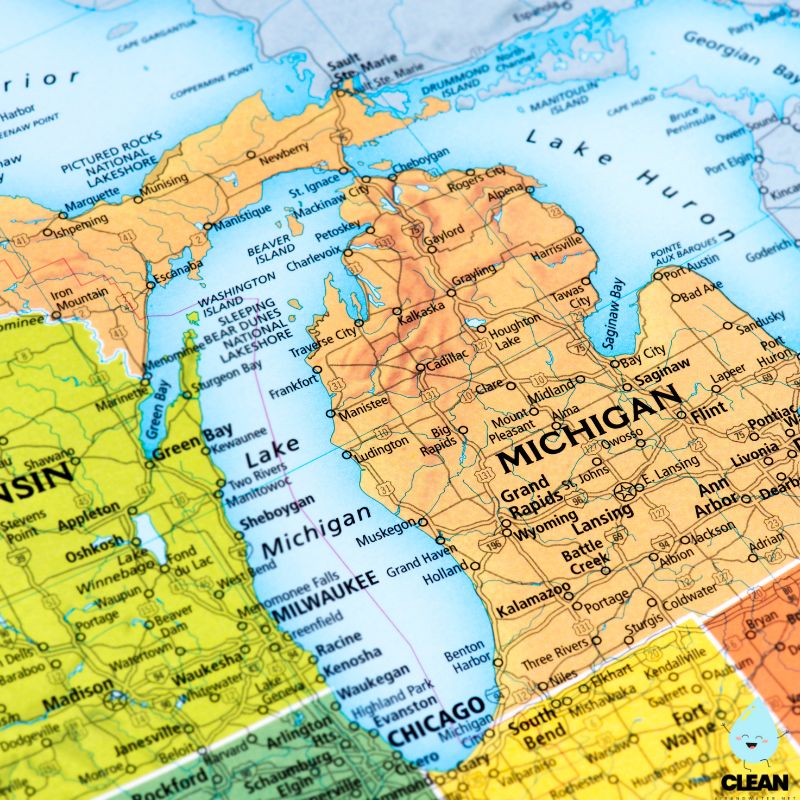Michigan Water Quality at a Glance
significant concerns
Is Michigan Water Safe to Drink?
Generally Yes, With Notable Progress and Concerns – Michigan has become a leader in water safety regulation with the strictest lead and copper rules in the nation and early PFAS standards. However, up to 3.2 million residents may be exposed to PFAS contamination from 300+ known contamination sites. While Flint’s water crisis recovery shows significant improvement, the legacy highlights ongoing vigilance needs. Michigan’s proactive regulatory approach sets a national example for water safety protection.
⚠️ Key Concerns for Michigan Residents
- PFAS “Forever Chemicals”: 3.2 million Michiganders potentially exposed; 300+ official contamination sites including military bases and industrial facilities
- Historical Industrial Legacy: Wolverine Worldwide tannery, electroplating facilities, and military installations created widespread contamination
- Lead Service Lines: Despite progress in Flint and stricter rules, many communities still have lead pipes requiring ongoing replacement efforts
- Private Well Risk: 1-in-3 residents may use PFAS-contaminated groundwater; private wells lack routine monitoring and federal regulation
✅ Michigan’s Water Safety Leadership
- Strictest Lead Rules: Michigan Lead and Copper Rule requires 5th-liter sampling and lowers action level to 12 ppb in 2025
- Early PFAS Regulation: Established PFAS drinking water standards in 2020, ahead of federal regulations
- MPART Response Team: Dedicated multi-agency team for coordinated PFAS contamination response since 2017
- Flint Recovery: 98% of residential lead service lines replaced; water now meets all federal standards
Read the full report below for detailed analysis, city-specific data, and actionable recommendations for Michigan residents.
Michigan – The Great Lakes State – Water Quality Report 2025: PFAS Testing, Infrastructure Concerns & Safety across your state
Michigan’s water infrastructure serves approximately 10.1 million residents across the Great Lakes region, managing 20% of the world’s freshwater supply. The state operates through a complex network of thousands of public water systems, ranging from large municipal utilities like the Great Lakes Water Authority, which serves approximately 3.9 million customers across 126 municipalities in southeast Michigan, to smaller community systems providing essential services throughout the state’s diverse geography. Michigan’s water sources include the Great Lakes, numerous inland lakes, rivers, and groundwater aquifers that supply both urban centers and rural communities.
Despite abundant freshwater resources, Michigan faces significant infrastructure and contamination challenges. According to the American Society of Civil Engineers’ 2023 Infrastructure Report Card, Michigan’s drinking water infrastructure received a D+ grade, highlighting aging systems, funding shortfalls, and emerging contaminant concerns including widespread PFAS “forever chemicals” contamination. The state has received substantial federal infrastructure investments and has committed over $4 billion since 2019 to address these challenges, focusing on drinking water safety, lead service line replacement, and PFAS remediation. Michigan’s proactive approach to water quality improvement is demonstrated through comprehensive PFAS testing programs, the Michigan PFAS Action Response Team (MPART), and partnerships between the Department of Environment, Great Lakes, and Energy (EGLE), local utilities, and federal agencies working to ensure safe, reliable water access for all residents.

Michigan Water Quality: Current Status (2024-2025)
Statewide Compliance and Testing
- Overall Compliance: Most of Michigan’s public water systems meet federal Safe Drinking Water Act standards, though the state faces significant PFAS contamination challenges with over 300 documented contamination sites identified by MPART, with investigations ongoing at thousands of additional locations where PFAS use is suspected.
- PFAS Monitoring Leadership: Michigan became the first state to test all public drinking water supplies for PFAS and established its own drinking water standards in August 2020, serving as a national model for comprehensive “forever chemical” monitoring and regulation ahead of federal EPA standards.
- Infrastructure Investment: Over $4 billion in state and federal funding has been committed since 2019 for water infrastructure improvements, including $865 million in grants awarded since 2022 for lead service line replacement, PFAS treatment, and system upgrades across communities statewide.
Major Water Sources and Challenges
- Great Lakes Water Authority: Serves approximately 3.9 million customers across 126 municipalities in southeast Michigan, with comprehensive PFAS testing showing non-detect levels in treated drinking water from the Great Lakes system, representing nearly 40% of Michigan’s population.
- Private Well Contamination: Up to 3.2 million Michiganders may be receiving water from PFAS-tainted aquifers according to federal studies, with over 165,000 private wells in the Detroit metro area alone requiring individual testing and potential treatment for PFAS contamination.
- Aging Infrastructure: Most of Michigan’s community water supply systems are over 50 years old, with a significant portion approaching 100 years of service life, requiring comprehensive modernization and replacement programs with an estimated annual funding gap of $860 million to $1.1 billion.
PFAS Contamination Response
- Comprehensive Site Inventory: The Michigan PFAS Action Response Team (MPART) has identified over 300 confirmed contamination sites with investigations ongoing at thousands of additional locations where PFAS use is suspected from industrial, military, and commercial activities including automotive manufacturing, military bases, airports, and paper mills.
- Federal Standards Impact: New EPA drinking water standards for PFOA and PFOS (4 parts per trillion) were scheduled to require compliance by 2029, though recent federal policy changes under the Trump administration in 2025 have created uncertainty about enforcement timelines and scope for these forever chemical regulations.
- Treatment Technology Deployment: Water utilities are implementing advanced treatment technologies including activated carbon filtration and reverse osmosis systems, with state programs providing technical and financial assistance for smaller systems to meet PFAS treatment requirements.
Lead Service Line Replacement
- Inventory Requirements: All water suppliers were required to complete service line material inventories by October 2024 to identify lead service lines, with residents receiving notification within 30 days if their home has a lead service line under Michigan’s enhanced Lead and Copper Rule requirements.
- Stricter Standards: Michigan’s lead action level decreased from 15 ppb to 12 ppb on January 1, 2025, with enhanced sampling protocols including fifth-liter testing showing significant reductions in lead exceedances from 13% in 2019 to 3% in 2023, demonstrating the effectiveness of stricter regulations.
- Replacement Programs: Dedicated funding streams provide grants and low-interest loans for lead service line replacement, with cities like Flint achieving 98% completion of residential lead service line replacements and comprehensive infrastructure modernization efforts funded through state and federal partnerships.
Looking Forward: 2025-2030
Michigan’s water quality landscape continues evolving as utilities prepare for potential changes to federal PFAS regulations and ongoing lead service line replacement mandates. The state’s leadership in PFAS monitoring and regulation, combined with substantial infrastructure investments, positions Michigan as a national model for addressing emerging water quality challenges. However, successful implementation will require continued collaboration between state regulators, water utilities, and communities to ensure that all Michiganders have access to safe, affordable drinking water while addressing the legacy of industrial contamination, aging infrastructure, and the unique challenges of protecting the Great Lakes system that serves as a global freshwater resource.
Recommendations for Michigan Residents

Know Your Water Source
Contact your water utility to request annual water quality reports and ask about PFAS and lead testing results. Private well owners should test their water through EGLE’s Drinking Water Analysis Laboratory at 517-335-8184 for $290 comprehensive PFAS testing, especially important given that up to 3.2 million Michiganders may be exposed to PFAS-contaminated groundwater.

Support Infrastructure Investment
Stay informed about local water infrastructure needs and support utility rate structures that enable necessary improvements. Attend public meetings when utilities discuss lead service line replacement and PFAS treatment investments, as Michigan faces an annual funding gap of $860 million to $1.1 billion for water infrastructure needs.

Consider PFAS-Certified Filtration
For areas with known PFAS contamination, consider NSF-certified activated carbon or reverse osmosis filters specifically tested for PFAS removal. This is especially important for private well users in potentially contaminated areas, as Michigan has over 300 documented PFAS contamination sites with investigations ongoing at thousands more locations.

Report Water Quality Concerns
Contact your local water utility immediately for taste, odor, or color concerns. Report suspected contamination to EGLE for investigation and follow-up, and check if your area is included in MPART’s ongoing contamination site investigations through their comprehensive database of documented PFAS sites.

Protect the Great Lakes
Support Michigan’s Great Lakes protection through conservation measures, proper disposal of household chemicals, and participation in volunteer water quality monitoring programs through Michigan Clean Water Corps (MiCorps), as the Great Lakes provide 20% of the world’s freshwater supply and serve as the primary source for the Great Lakes Water Authority.
Michigan Cities We Cover
Detroit Water Quality
Comprehensive analysis of Detroit’s water systems, including Great Lakes Water Authority services, infrastructure modernization efforts, PFAS monitoring, and lead service line replacement programs serving Michigan’s largest metropolitan area with 3.9 million customers across 126 municipalities.
Flint Water Quality
Detailed assessment of Flint’s water recovery following the 2014 crisis, current lead monitoring results showing 98% completion of residential lead service line replacements, infrastructure replacement progress, and ongoing efforts to rebuild community trust in municipal water systems.
Frequently Asked Questions
Is Michigan’s tap water safe to drink?
Most of Michigan’s public water systems meet federal drinking water standards and are generally safe for consumption. However, widespread PFAS contamination affects numerous communities.
Michigan was the first state to test all public drinking water supplies for PFAS and has over 300 documented contamination sites. MPART estimates up to 3.2 million Michiganders may be receiving water from PFAS-contaminated aquifers. The Great Lakes Water Authority reports non-detect levels in treated water, but many smaller systems and private wells show contamination. Lead levels have decreased significantly due to enhanced regulations, but residents should request current testing results from their water utility and consider certified filters for additional protection.
Why does Michigan have such widespread PFAS contamination?
Michigan’s industrial history and proactive testing have revealed extensive PFAS contamination from decades of manufacturing, military, and commercial use.
The state’s automotive and chemical manufacturing industries historically used PFAS in production processes, while military bases and airports used PFAS-containing firefighting foam. Paper mills, metal finishing operations, and landfills also contributed to contamination. Michigan’s comprehensive testing program, led by MPART since 2017, has identified contamination that other states might not have discovered yet. Up to 3.2 million Michiganders may be getting water from PFAS-tainted aquifers, with over 300 confirmed sites and thousands more under investigation.
How can I find out about my local water quality in Michigan?
Michigan residents can access water quality information through several comprehensive resources:
• Annual Water Quality Reports: Contact your water utility directly for their Consumer Confidence Report, which details all testing results including PFAS and lead levels
• EGLE MiEHDWIS System: Visit Michigan’s Environmental Health and Drinking Water Information System online to access testing results and compliance information for your local water system
• MPART Site List: Check if your area is included in the 300+ documented PFAS contamination sites through EGLE’s PFAS Action Response Team database
• Private Well Testing: Contact EGLE’s Drinking Water Analysis Laboratory at 517-335-8184 for $290 comprehensive PFAS testing if you have a private well
What is Michigan doing about water infrastructure challenges?
Michigan has made substantial investments to address aging infrastructure and contamination:
Major Funding: Over $4 billion committed since 2019 through state programs like MI Clean Water Plan and federal infrastructure investments
Lead Service Lines: Mandatory inventory completion by October 2024, with enhanced regulations lowering the action level to 12 ppb in 2025
PFAS Response: Michigan established the first comprehensive state PFAS standards in August 2020 and created MPART to coordinate cleanup efforts at contaminated sites
Grant Programs: EGLE awarded 185 grants totaling $865 million since 2022 to local communities for water infrastructure improvements, with programs specifically targeting disadvantaged communities and emerging contaminant treatment
Despite these investments, the American Society of Civil Engineers still rates Michigan’s drinking water infrastructure as D+, indicating continued need for sustained funding and modernization efforts with an estimated annual gap of $860 million to $1.1 billion.
Contaminants of Concern

PFAS “Forever Chemicals”
Source: Industrial manufacturing from automotive and chemical industries, military bases using firefighting foam, paper mills, metal finishing operations, and consumer products disposal, with Michigan’s industrial legacy contributing to widespread contamination
Health Effects: Linked to kidney, liver, and testicular cancer, immune system suppression, high cholesterol, developmental effects in children, and other serious health impacts from long-term exposure to these persistent chemicals
Current Status: Over 300 documented contamination sites statewide with MPART investigating thousands more potential locations. Up to 3.2 million Michiganders may be receiving water from PFAS-tainted aquifers according to federal studies, representing one-third of state residents
State Standards: Michigan established drinking water standards in August 2020, ahead of federal EPA standards (4 ppt for PFOA/PFOS) that were scheduled to take effect in 2029 but face uncertainty due to 2025 federal policy changes

Lead from Service Lines and Pipes
Source: Aging lead service lines and plumbing fixtures throughout Michigan’s water distribution systems, particularly in older communities with infrastructure dating back decades or over a century, including areas affected by the Flint water crisis
Health Effects: Neurological damage, developmental delays in children, cardiovascular effects, kidney damage, and reproductive problems, with no safe level of lead exposure according to health authorities
Current Status: Michigan’s enhanced Lead and Copper Rule requires service line inventories completed by October 2024, with action level decreased to 12 ppb in January 2025. Lead exceedances dropped from 13% to 3% between 2019-2023, with Flint achieving 98% lead service line replacement
Regulatory Response: Mandatory lead service line identification and replacement programs with dedicated state and federal funding assistance, featuring the strictest Lead and Copper Rule requirements in the nation
Please read – our information
The information presented on cleanairandwater.net is compiled from official water quality reports, trusted news sources, government websites, and public health resources. While we strive for accuracy and thoroughness in our presentations, we are not scientists, engineers, or qualified water quality professionals.
Our mission is to present water quality information in an accessible, real-world format that helps people understand what’s in their water and make informed decisions about their health and safety. We believe that complex environmental information should be available to everyone in a format that’s easy to understand.
We make every effort to ensure our content is current and accurate, but we cannot guarantee that all information is complete or error-free. This website should not replace official communications from your local water utility or health department. We always recommend consulting official sources for the most up-to-date information regarding your specific water system.
Clean Air and Water is not liable for any unintentional errors, omissions, or outdated information. The content on this site is provided for informational purposes only and should not be considered professional advice.

